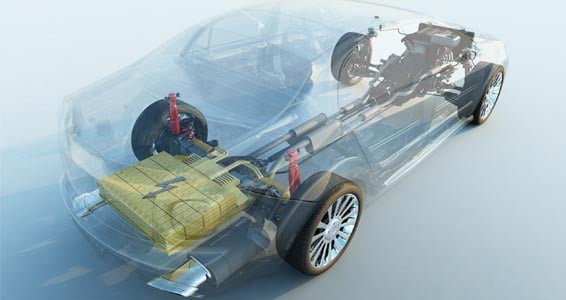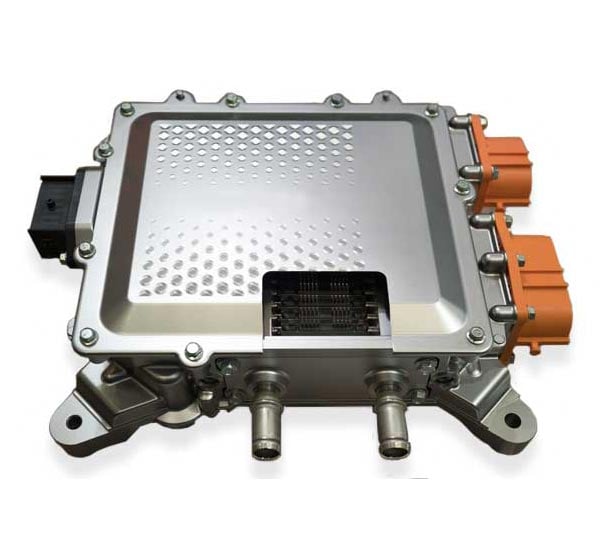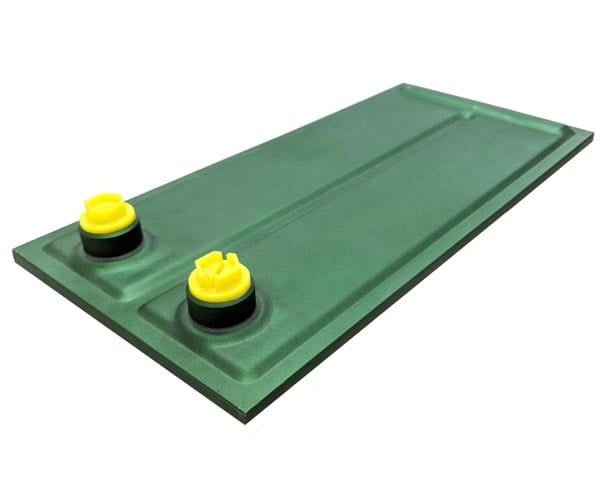Liquid Cooling Solutions in Electric Vehicles
Overview
This paper addresses current and upcoming trends and thermal management design challenges for Electric Vehicles and eMobility with a specific focus on battery and inverter cooling. Liquid Cooling is extremely efficient to handle higher heat loads, but systems must be designed to optimize size, weight, performance, reliability, and durability. Through advanced design and technology integration, Boyd is working with designers to accomplish these goals in a way that meets current requirements, enables next generation innovation, and contributes to overall vehicle performance and driver satisfaction. This article will aid engineers in understanding the role of liquid cooling to improve system development and foster design creativity.
This article is a general discussion on the topic of noise and vibration control and analysis techniques from the perspective of someone who has worked as a consultant in this field of study for many years. At Boyd, we strive to bring this consultative, problem solving approach to how we support our customers' issues utilizing a systematic and analytical thought process to understand the governing dynamics of a problem in order to best recommend the most appropriate countermeasures.

Current Electric Vehicle Market Trends
The Transportation market is currently undergoing a significant, fundamental transformation towards eMobility. Global trends ranging from environmental awareness, historical gas crises, and urbanization combined with customer demands for greater connectivity, safer driving, maximum efficiency, sustainability, and cost savings have culminated in the exponential growth in demand for and use of Electric Vehicles (EVs).
The global electronic fleet has risen dramatically over the last decade; by 2019 there were an estimated 5,6 million electric vehicles on the road with market experts estimating that more than half of new cars will be electric by 2040.
Concerns the previously limited electric vehicle adoption have been addressed, such as battery costs, safety, reliability, charging station availability, and technology limitations. Currently, batteries charge faster, power is more efficiently converted and electronics' speed, complexity, connectivity and processing power increase. However, a new barrier to market scalability and growth is created as a by-product: more heat.
Advancements including longer lasting, higher performing batteries, greater connectivity, more accurate and connected sensors, enhanced system monitoring, faster charging, and improved cabin features are producing much higher heat loads. In addition to this enhanced performance and functionality, Manufacturers are demanding smaller, lighter form factors. The excess heat generated by so much power in such a compact form can easily lead to system failures and threats to passenger safety if not managed efficiently and effectively.
Each EV generation has gotten lighter, safer, more reliable, and better connected, and will continue to do so for each new model to come. It will be imperative that cooling solutions progress ahead of vehicle innovation for each new advancement to test and prove safety and reliability.
Boyd has aligned closely with key eMobility innovators and design teams over the past two decades to ensure that our thermal management solutions exceed industry advancements to empower future innovation. This close collaboration has enabled Boyd engineers to anticipate upcoming market changes, industry trends and evolving design requirements to influence our research and development, guide technology roadmaps, and start development early for improved thermal solutions and system integration. This practice not only leads to more optimized, cost-efficient cooling with greater reliability, but also faster time to market, lower overall costs, and a significant competitive advantage to OEMs.
Solving Key Challenges in Emobility Cooling
Overall Environmental & Use Considerations
There are several critical considerations surrounding all thermal management systems within electric vehicles, one of the most significant being environmental conditions. Vehicles must be able to operate with guaranteed performance, safety and reliability in conditions with varying temperature extremes, humidity levels, precipitation, exposure to sand, saltwater and other environmental factors. Vehicles may also be subjected to rugged terrain, extreme shock and vibration, collision impact, electromagnetic interference from advanced electronic systems and many other factors. Critical components and systems must be designed to protect against known possible hazards while still being serviceable, easily maintained and cost efficient.
Optimized design starts with selecting the best-fit materials for specific performance and environmental exposure in streamlined geometries that integrate multiple functions into a solution that minimizes material and assembly costs, like integrating protection and structural functionality into a cooling solution. Rigorous testing and quality assurance are also a key aspect to maintain reliable high performance in challenging environments.

Challenge: Battery & Inverter Cooling
The most significant technologies engendering eMobility growth and adoption are batteries and inverters, which convert battery energy into mechanical power to propel a vehicle.
There is a correlation between battery cost reductions and EV adoption which has led to engineering focus on battery cost savings. Improvements in battery capacity, charge speed and reliability have driven innovation to create lighter, smaller, and higher power batteries for better performance and lower overall cost of ownership. Cost saving measures and design innovation for batteries are leading to higher-density heat loads that must be managed in a compact form factor. Cooling systems must be developed to meet size, weight, and performance requirements, but also must not negate the cost reduction to the battery.
Higher heat flux inverters necessary to make electrical power viable for operating the vehicle add another layer of complexity to necessary heat rejection systems. Batteries and high heat flux inverters work together although their cooling requirements can be quite different. Battery thermal management relies on maximizing the surface area that can be uniformly cooled. Inverter power density varies by localized high power density heat sources requiring local hot spot heat spreading and cooling. Inverters must also be cooled below critical temperatures to optimize vehicle performance. A cooling system must be tailored for optimal cooling of batteries and various inverters from the same system, coolant, and cooling loop for space, weight, and cost savings.
Thermal Design for Battery & Inverter Cooling
Cooling traditional passenger vehicles has centered around a combustion engine, which has different thermal requirements and system design needs. Electric battery vehicles have an entirely new set of cooling needs with a completely different system design. Engineers must be inventive and forward thinking to fully utilize new technologies and redesign systems from the ground up while maintaining automotive safety protocols and standard functionality that drivers are accustomed to.
Combustion-powered vehicles require the engine system to thermally manage extreme exhaust temperatures from the combustion process. Using batteries rather than combustion eliminates the challenge of managing extremely high temperatures but introduces new design issues like managing electric conversion energy within the symbiotic relationship between batteries and inverters.
Integrated Liquid Systems have emerged as the most fitting solution to address new battery and inverter thermal challenges to satisfy growing eMobility customer needs. Liquid systems offer the most efficient cooling and flexibility in design to meet the requirements of both the battery and inverters within one central thermal system. Utilizing one optimized loop enables the best possible performance for every system component as well as savings in weight, space and cost.

Fully optimized Liquid Systems typically include:
- Cold Plates designed to fit heat source requirements for hot spot cooling or maximized surface area contact. It is vital to ensure that these cold plates are thoroughly tested and manufactured to be leak free, reliable, and extremely durable.
- Thermal Interface Materials and mounting hardware to ensure minimal loss during heat transfer from heat source to cooling system for maximized heat dissipation.
- Heat Exchangers and Radiators designed to dissipate heat as quickly as possible within confined quarters.
- Connectors, Hoses, Pumps, Reservoirs, and other hardware that ensure reliability, durability, and ease of system maintenance.
- Additional integrated technologies to improve performance and reduce system weight or size such as heat pipes, advanced engineered materials, fans, blowers, and advanced heat sink fin types.
In addition to the typical challenges of size, weight, performance, and cost (SWAP-C); the most significant difficulty in developing liquid systems for the engine compartment in electric vehicles is reconciling and managing the inherent differences in cooling requirements for batteries and inverters by one single cooling loop. The key to addressing these difficulties lies in cold plate design.
Key Cold Plate Considerations – Batteries
Maximizing the surface area cooled as uniformly as possible is the key to optimized battery cooling.
While battery cold plates do not require fin enhancements, like those in inverter cold plates, the fluid path within the plate must be carefully designed to cover as much surface as possible.
The heat flux density of batteries is much less than an inverter, however the cold plates are much larger to accommodate higher surface area contact and provide structural housing to bring fluid to the entire battery's peripheral area. This structural housing extends to the protection of battery packs and therefore the full assembly must be able to pass rigorous shock and vibration specifications.
Cold plates must be constructed to be not only larger but also thinner to optimize the number of cells that you can fit in the battery pack. This will play a big part in Design for Manufacturing (DFM) and how to engender cost savings. Diecast plates are not a viable option; Stamped Aluminum with shaped flow passages are the more optimal choice.
Within a battery array, there may be different voltage potentials where a dielectric material is required in conjunction with a compliant thermal pad. Proper combination of electrical barrier and thermal pads are imperative to achieve the best cooling jacket for a battery module.


Key Cold Plate Considerations – Inverters
Inverter operation generates a significant amount of heat that must be cooled dramatically to reach critical temperatures and meet performance requirements that propel the vehicle.
The heat flux of inverters is so great that the thermal interface to the cold plate is almost 50 % of total heat loss. Specific mounting and interface materials must be designed to attach the cold plate and provide higher compression loads with thin, high thermal conductivity materials.
Choosing the proper product construction and manufacturing process is more complex due to the wide range of design options in the industry. Common designs include, but are not limited to, brazed aluminum with or without fin enhancements, aluminum skived fins attached hermetically to a die cast fluid housing, and higher performing plated copper skived fins. For each option, designers must also consider how to optimize the material thermal conductivity and fin design with coolant flow and resultant pressure drop to make sure the vehicle cooling system is viable.
Previous die casting processes for cooling in a combustion engine are not an option for inverters as the thermal conductivity of die cast aluminum is lower than aluminum coil. Die cast aluminum can only be utilized for fluid housing and is less viable for contact with the inverter.
Additional Advancements in Battery & Inverter Cooling
Boyd has leveraged decades of experience, expertise, and innovations throughout all aspects of thermal management technology to develop optimized, integrated systems that exceed requirements and expectations in eMobility Cooling. By pioneering new technologies, refining manufacturing processes, and working closely in partnerships with industry leaders, Boyd is uniquely positioned to enable faster market growth and further market penetration for electric vehicles by mitigating past and current concerns. This includes advanced light weighting, better performance, integrated designs that provide more structural stability and functionality, and enhancements in how systems work together to lower costs and design volume.
Looking forward, future key considerations are likely to focus on greater flow control and enabling additional heat capacity as vehicles offer more safety, drive enhancements, greater connectivity and performance. Current solutions are designed for steady-state or worst-case constant load, which is a solid design strategy but may inhibit vehicle performance. Boyd is already working with eMobility customers to develop next generation thermal solutions that are better regulated to deliver cooling and optimized capacity to the right heat sources at the right time. Advancements include adding and configuring rapid valves to offer faster response times to move coolant through the system based on electronic device temperatures and real time power loading.
Additionally, Boyd’s development of better performing liquid to liquid heat exchangers brings additional heat capacity and coolant temperature reduction, especially in times of power cycling which may be transient and not steady state.
Challenge: Thermal Management for Charging And Charging Stations
Customers are demanding faster, more ubiquitous charging for electric vehicle batteries. Charger availability is a major contributor to adoption, market growth and differentiation for advancing EV brands. EV charging generates large amounts of heat over a sustained period that can fluctuate according to battery size and this poses unique safety and performance challenges.
Rapid charging requires greater voltage. Greater voltage means the thermal management system, specifically the cold plate, must be both thermally coupled and electrically isolated from the charge plug. The balance between high thermal conductivity and critical dielectric strength oppose each other when evaluating specific materials. This necessitates very specific design geometries and site locations for interface solutions in conjunction with maximum performance cold plates.

Fortunately, with charging stations, engineers have the option to utilize ambient air cooling solutions that couple to the charge port and remove heat directly to the surrounding environment which is cooler than a closed engine compartment. Engineers can lessen the size and weight of liquid solutions by leveraging ambient cooling. However, utilizing ambient air often means that charging stations are exposed to the elements and harsh environmental conditions, so components and enclosures must be protected. These nuances and design considerations cause charging station cooling to be more complex than many design engineers realize.
To overcome these unique challenges, Boyd leverages exhaustive testing, unique advanced materials, and extremely reliable solution integrations. Integrated thermal systems are customized to maximize the performance of each component and ensure that system performance is greater than the sum of its parts.
Challenge: Wide Range of Interlocking Electronics Systems
In addition to the number of electronics systems that propel the vehicle, there is a wide variety of other technologies within the engine compartment, cabin, and vehicle exterior that enable additional functionality. Connectivity and smart systems are advancing at the same exponential pace as Electric Vehicles. Sensors, cameras, control modules, infotainment, energy saving modes, system monitoring, touch screens, and voice recognition are all becoming standard technologies. New, innovative technologies and systems continue to emerge. Autonomous driving is also on the rise, bringing with it a new set of computing and safety needs and complications.
As functionality exponentially evolves, CPUs and GPUs necessary to power these operations are innovating in processing power and speed, producing greater amounts of heat and adding new heat sources. Extremely thin heat spreading is paramount to handling new excess heat as well as integration with the core liquid cooling system and cold plates.
Boyd Advantage in eMobility Cooling Systems
As the functionality and adoption of electric vehicles and eMobility applications increase and battery size decreases, the key limiting factor continues to be thermal management. Components are generating significantly more heat, but vehicle form factors remain the same or smaller. Without more room to adequately dissipate heat, the only option is more advanced, higher efficiency cooling systems. Developing these more effective solutions to meet size, weight, and performance requirements without sacrificing cost efficiency will require extreme attention to detail in all aspects of cooling design and material selection.
Boyd focuses on developing forward-thinking, high-performance systems with a single cooling loop, integrated components, and advanced technologies for optimized regulated cooling and rapid transitioning. Boyd's focus on innovation and customer partnerships ensures that our cooling systems are as innovative as the vehicles they support. Our commitment to eMobility research and development assures our innovation stays ahead of the next generation's requirements.
Have questions? We’re ready to help!
